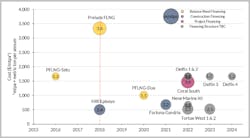LONDON– Financing is critical to the success of floating LNG (FLNG) projects, says consultant Westwood Global Energy Group in a new report.
These projects require significant capital investments, it points out, and despite the fact that FLNG liquefaction is not new only three vessels at present are either operational or undergoing commissioning.
Petronas and Shell ventured into balance-sheet funding to help construct their own FLNG facilities, thePFLNG-Satu and the PreludeFLNG.
Other companies, however, have either delayed financing decisions or cancelled FLNG projects altogether, so that only one additional facility, Golar LNG’s convertedHilli Episeyo, is set to start operating this year for Perenco offshore Cameroon.
Westwood estimates the respective costs of thePFLNG-Satu and Prelude FLNG at around $2 billion and $12 billion. These were pioneering projects with no technological precedents, the consultant pointed out, so securing external funding was probably unrealistic given the associated risks.
But the two operators also had the funds in place and direct oversight over these projects and could therefore sustain the commercial risks. In both cases, they entrusted design and construction to well-established contractors, addressing the technology and construction/completion risks, and the attendant country (Malaysia/Australia) and offshore field reserve risks were relatively low.
In addition, both operators had experience operating LNG facilities and can be viewed as the “offtakers” on their respective FLNG projects.
Westwood points out that Golar LNG secured around 80% of the construction financing for re-conversion of theHilli Episeyo FLNG vessel from China State Shipbuilding Corp., and that this will ultimately transition into a sale and leaseback structure.
Financing for theGolar Gandria (Ophir’s Fortuna FLNG vessel) off Equatorial Guinea could potentially come from an Asian bank or lender.
Eni’sCoral South FLNG project offshore Mozambique has so far attracted project financing of $4.7 billion from a consortium of banks and export credit agencies.
In Westwood’s view, for future FLNG projects operators will be less likely to consider balance-sheet funding (as they focus on preserving their liquidity).
A construction financing/sale and leaseback structure may appeal in situations where project financing is not ideal (depending on the size of project and terms offered by commercial banks).
The success of the current FLNG projects should give lenders (i.e. banks) greater confidence in the FLNG sector.
BP/Kosmos’ Tortue West FLNG facilitiesoffshore Mauritania/Senegal could potentially attract project financing, considering the estimated project size ($4 billion) and the two companies’ credit ratings.
03/08/2018



